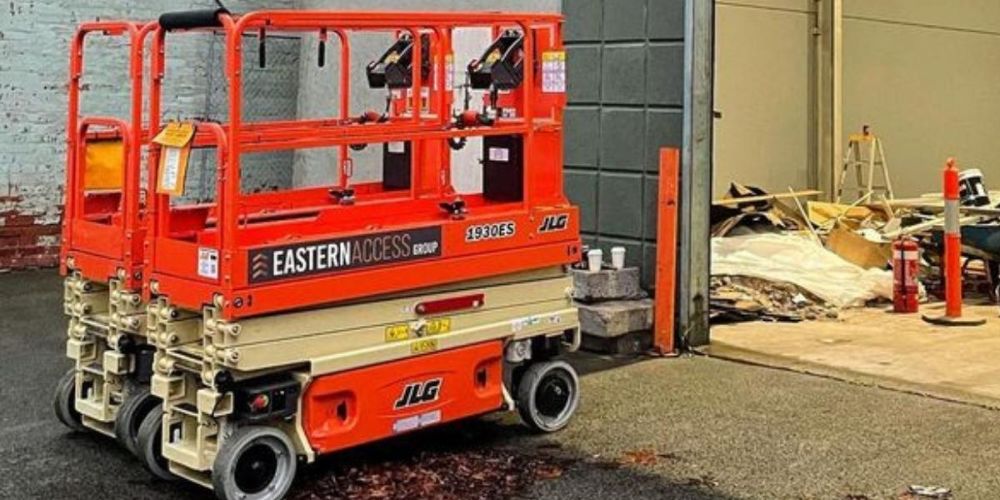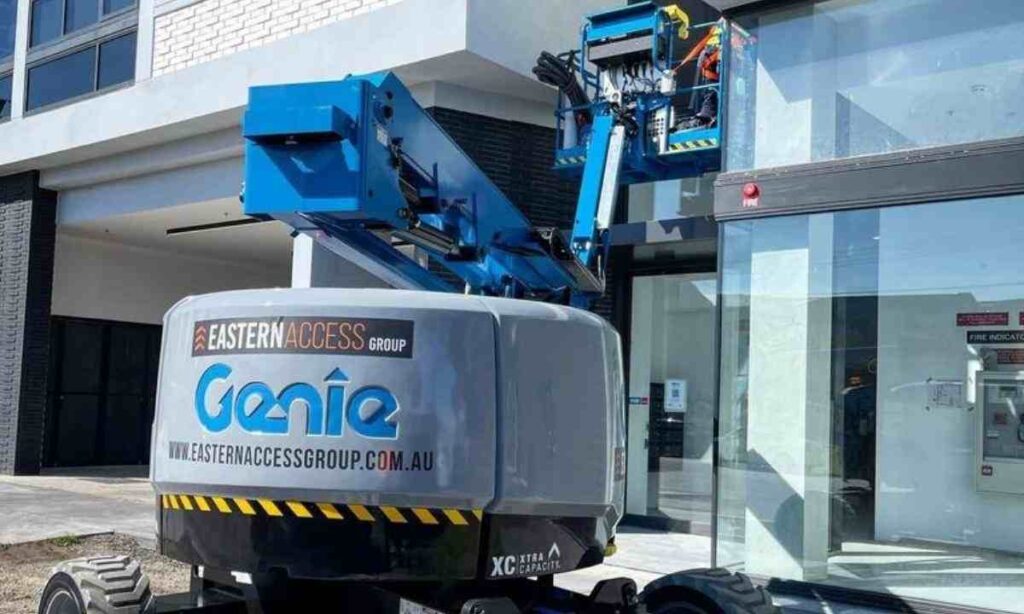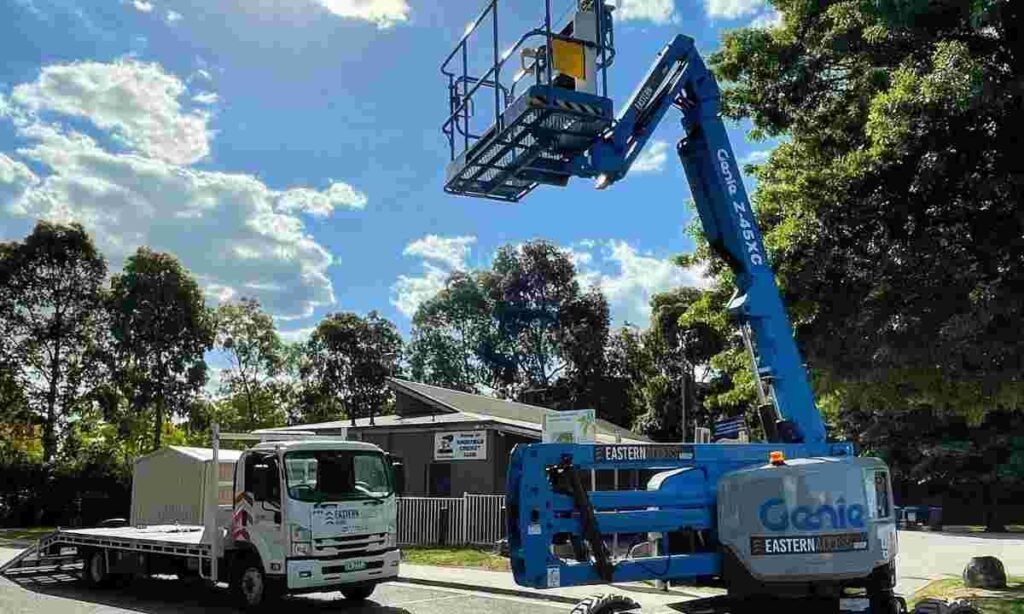An Introduction to Elevated Work Platforms
An elevated work platform (EWP), known as a mobile elevating work platform, is used to designate any self-propelled, trailer, and truck-mounted designs. It is intended to transport people, tools, equipment, and materials to work locations and comprises a work platform with controls.
Table of Contents
Basic Types of Elevated Work Platform

Scissor- type
Scissor-type EWPs are work platforms that can move in the vertical plane and on which humans, materials, and equipment can be lifted to accomplish work. It cannot telescope or rotate. A pantograph is a series of linked folding supports in an ‘X’ pattern that elevates the enclosed platform. These can be utilised in both indoor and outdoor locations where access requires a straight vertical lift. Pressure is applied on the lowest set of supports, causing the crisscrossing supports to lengthen and the platform to rise. Scissor-type EWPs are powered by diesel and have capacities ranging from 500 to several thousand pounds and platform heights of 15 m (50 ft) or more.
Types of Scissor-type Elevated Work Platforms
1. Hydraulic Scissor Lifts
Hydraulic scissor lifts are used both indoors and outside. They are powered by an electric motor or compressed air. The hydraulic liquid is moved or drained from cylinder to cylinder, allowing the scissor lift to rise and fall as needed. Hydraulic scissor lifts are used in warehouses, construction sites, and infrastructure projects.
2. Diesel Scissor Lifts
Traditional diesel engines power diesel-powered scissor lifts. They are not as environmentally beneficial as electric equivalents because they are noisy and create polluting exhaust fumes when in use. The diesel scissor lifts often have larger platforms and are used on outdoor construction projects, in well-ventilated inside locations, and where engine noise will not distract or disturb vital employee communication.
3. Electric Scissor Lifts
Electric scissor lifts are more environmentally friendly because they are charged by batteries rather than a combustion engine. Because there are no exhaust emissions or loud noises when working, they are suitable for interior use. Electric scissor lifts are often smaller, less bulky, and have narrower platforms than diesel-powered counterparts. Because they work indoors, devices are frequently equipped with non-marking tires to prevent floor damage during operations.
4. Rough Terrain Scissor Lifts
Rough terrain scissor lifts have greater power for use in harsh outdoor conditions. They are fueled by combustion diesel, petrol, or LPG engines to provide the traction and travel speed required to navigate big construction sites stably.
5. Pneumatic Scissor Lifts
Pneumatic scissor lifts are driven by air rather than electricity or hydraulics, resulting in a clean and maintenance-free lift. They use air pressure to raise and lower the lift, making them suitable for ecological conscious enterprises.
Advantages of Scissor-type Elevated Work Platform
1. Access Heights and Difficult-to-Reach Areas
Scissor lifts, with lift heights of up to 16m, enable workers to reach high off-the-ground regions. Workers can get access to difficult-to-reach regions to do maintenance, repairs, or cleaning.
2. Easy Operation
The controls for scissor lifts are simple and easy. Operators can be trained in a relatively short period.
3. Compact Size
Scissor lifts are the smallest and most portable sort of elevating work platform. They can be used in tiny and tight locations where access is limited.
4. Range of Options
The extensive range of power plants, lift capabilities and heights, platform sizes, and safety features provide maximum flexibility when selecting the right scissor lift for a specific application.
5. Reduce Workplace Injuries
Scissor lifts are a convenient and safe way to raise things to a particular height. It drastically decreases the chance of workers injuring themselves, their backs particularly, while manually lifting goods. R-aising the worker to the proper height to conveniently put away loads to eliminate the risk of strains from horizontal or vertical plane lifting. Scissor lifts can help lessen the probability of repetitive strain injury in workers.

Boom Type
Boom-type EWPs, often known as cherry pickers, telehandlers, and telescopic handlers, are distinguished by a long, extendable arm with a cradle connected to the end. These are the most adaptable EWPs since the operator can move the work platform in numerous directions to access the appropriate workspace without repositioning the vehicle. These are versatile and multi-purpose, perfect for jobs that demand the user to work at height in inconvenient situations.
Variations of Boom-type Elevated Work Platforms
1. Mast Lift
This provides a caged platform to keep users safe. This is small enough to fit in small areas and busy environments.
2. Stick boom-lift
Also known as a telescopic boom; this provides a wide range of movement, similar to a cherry picker. The platform may expand horizontally and vertically, and it is frequently used to move around and over obstructions, machines, or structures.
Three Motive Mechanisms of an Elevated Work Platform
Because EWPs are meant for temporary employment, they usually require transportation between locations or merely around a single site. They are constructed for ease of movement and the ability to ride up and down ramps.
1. Self-propelled
These machines can drive themselves around a location (on wheels or tracks). They usually require to be transferred to a site for reasons of safety and economy. The power source can be practically any type of mechanical drive system, including electric, gasoline, or, in certain situations, a hybrid, where it can be used both inside and outside.
2. Unpowered
These smaller machines lack a motor drive and must be moved by an external force. Small non-powered EWPs are light enough to travel in the bed of a truck and can typically be pulled through a regular doorway.
3. Vehicle-mounted
Some units are attached to a vehicle, most commonly a truck. They can be put on a self-drive flat-back pick-up van, however other vehicles, such as flatcars, are also viable. This vehicle provides mobility and may also aid in unit stabilization — outrigger stabilisers are still common, especially since vehicle-mounted EWPs are among the largest of their kind. The truck can also be used as a mobile workshop or store, increasing its functionality.
Two Basic Types of Elevated Work Platform Models
1. On-slab Types
They are used on level hard surfaces like pavement or concrete.
- Not built for uneven or sloping ground
- Have solid rubber tires
- Generally powered by rechargeable DC battery
- Some are driven by an internal combustion engine, either gasoline or propane
- Most have “pothole protection,” which is a metal plate dropped near to the ground to provide some protection from unintended movement into the trash.
2. Rough-terrain Variants
They are utilized on firm, level surfaces like graded and compacted soil or gravel.
- Design is similar to that of on-slab machines
- Designed to withstand harsh off-slab challenges
- Typically have broader wheelbases, larger wheels, and pneumatic tires – Some are equipped with outriggers for added stability – Typically powered by internal combustion engines, such as gasoline, diesel, or propane
- DC units are also available
- Hydraulic lifting mechanism.
Uses of Elevated Work Platforms
1. Building and Construction Maintenance
The most prevalent types of raised work platforms used in construction are aerial lifts, articulating boom lifts, and telescopic boom lifts. EWPs are built to reach maximum height – difficult-to-reach buildings. They are used to reach up and around structures to reach items like heat and cooling units, ductwork, and piping.
Aerial and telescopic boom lifts are the devices when it comes to installing and repairing ductwork, accessing high-up wiring, or adding structural features at height. These EWPs can operate on both even and uneven ground and are perfect for tough natural terrain and unfinished construction projects.
2. Electrical Line Repair
EWPs are used to access telephone companies, industrial construction enterprises, and transformers. They are utilised in electrical installation operations to route conduit, repair electrical connections, and update equipment.
3. Filming
For pictures that require an elevated angle above a scene, cameras can be put directly atop a boom-type and controlled remotely to provide sweeping aerial shots.
4. Indoor Retail Areas and Warehouses
Electric scissor-type EWPs are used indoors as they can only expand vertically, straight up from the base, and by a series of crisscrossing beams. They are utilised to convey boxes, shipments, equipment, and other industrial products in many packing activities and do building maintenance and repairs in retail situations. Many electric scissor lifts have narrow platforms and are utilized in warehouses to handle a variety of weights. Because they do not release fumes, they are suitable for use in the presence of citizens and workers.
5. Orchard Work
Boom-type EWPs earned their name since they were built and used for reaching and collecting fruits in orchards. These devices transformed how workers picked fruit and ensured that the best fruit was always gathered safely — with no risk of falling. They have also made selecting fruit more efficient by reducing time and lowering the danger of fruit loss due to falls.
The Boom-type EWPs are thin enough to maneuver between rows of fruit trees while carrying one worker in the bucket. The boom arm and bucket are mounted on a truck chassis, allowing personnel to access typically difficult-to-reach areas.
6. Repair and Cleaning Maintenance
These EWPs are designed with a basket or bucket on the end of the boom arm to accommodate employees and the tools needed in installing, repairing, and cleaning windows. Cleaning and maintaining the more difficult-to-reach, lower-parts properties has become much easier and safer thanks to EWPs. Workers are no longer required to use ladders or scaffolding while transporting tools, buckets, and other equipment.
Telescopic boom lifts are used for window work. They can lift and position the window washer directly in front of the work area.
7. Roller Coaster Repair and Maintenance
EWPs are ready to use and access a roller coaster if any failures occur, potentially locking park visitors on the ride. Telescopic boom lifts have the reach power required to access the highest point of many roller coasters and may even transport riders to safety in an emergency.
8. Safety Inspections
EWPs are the most efficient means to convey engineers, inspectors, and other safety personnel to their destinations. These are used for accident investigations to mimic occurrences that resulted in an on-the-job mishap and conducting routine inspections in warehouses, manufacturing facilities, and other locations across the country.
9. Special Event and Entertainment Work
EWPs are used by celebrities or performing artists to hoist them above the crowd and transfer them around a stage to increase the wow factor of their performances. EWPs are used in setting-up of special events behind the scenes — installation of the lighting for concerts, hanging of speakers and banners, and more. They are also used in amusement parks like Disneyworld and Universal Studios to build and repair rides.
10. Sporting Events
EWPs can be used for sporting events because of their ability to lift and lower event staging and lighting. Scissor lifts utilise everything from reaching scoreboards and arena buildings to providing an eagle-eye view.
11. Tree Care Work
EWPs are used for residential and business sites. Arborists frequently use an EWP to access portions of trees that need work. Landscapers, tree trimmers, and other similar employees cannot approach trees without these.
Climbing a tree carries several risks, and an EWP can assist arborists in avoiding accidents. EWPs are alternatives on-site to get the job done securely and efficiently.
Reasons to Choose Elevated Work Platforms
There are numerous EWPs available to you, and these devices provide benefits, including:
- They are inexpensive and typically give a long-term return on investment.
- They are simple to operate; workers may quickly learn to maneuver in work scenarios with an EWP training course.
- They are often small enough to fit through single and double entrances.
- They typically only require one operator who can rapidly set up and begin utilising the machine.
- They are versatile and can work for a wide range of commercial applications.
Conclusion
Elevated work platforms, regardless of the task at hand, can provide best-raised productivity. As a result, you must examine the task at hand, what you aim to achieve, and which elevated work platform will assist you in completing your job securely and efficiently.

